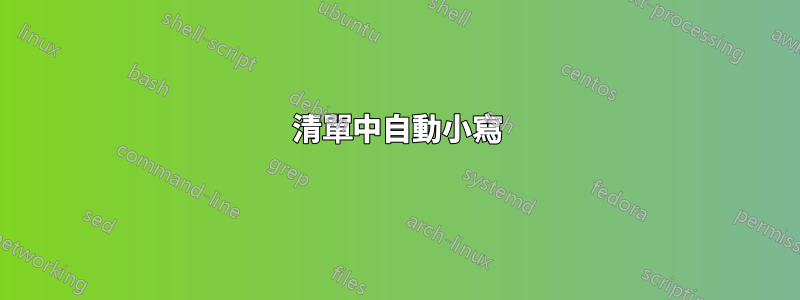
我相信這是一個非常簡單的問題,可能有一個非常簡單的答案,到目前為止我還沒有找到:如何將常規列表LaTeX2e(例如enumerate)中每個項目的文本強制排版為全小寫?我的問題是\lowercaseor\MakeLowercase是需要分隔參數的命令,而 an 則不是這樣\item,因為它作為控制序列工作。我的動機:有時我希望將項目列表中的文本排版為小型大寫字母,並且所有字符都與小寫字母高度相對應,但我希望能夠這樣做而無需在 a 上使用上述命令手動的每個項目的基礎上。最簡單的答案(只需以全小寫形式輸入文本)不會成為有用的答案,因為我希望能夠使用相同的文本,而無需重新輸入它,作為常規\upshape文本。
編輯:我已將 A. Ellett 的提案勾選為答案,因為它的功能符合我的問題,並且因為我認為它本身就是一個有價值且經過深思熟慮的貢獻。儘管如此,如果可行的話,更簡單的方法仍然會受到歡迎。
答案1
此更新版本(請參閱舊版本的修訂歷史記錄)不需要使用者在其環境中新增任何功能。不需要\item*或類似的東西。這是透過在\item第一次迭代中走私然後轉移(重新定義再次)\item。我添加了廣泛的註釋,應該允許您修改此程式碼以更好地滿足您的需求。
\documentclass{article}
\usepackage[T1]{fontenc}
\usepackage{lmodern}
\makeatletter
%% We will use two versions for redefining \item
%% The first version is temporary and only used
%% for the first iteration. It's purpose is to
%% allow us to slip in an \item just before the
%% environment is ended.
\def\@ae@item@va@#1\item#2\@nil{%%
\def\item##1\end{\@ae@item@vb@##1\@nil}%%
\@ae@item@vb@#1\item#2\@nil}
\def\@ae@item@vb@#1\item#2\@nil{%%
%% Don't immediately pass to \olditem
%% we need to see whether there's any optional
%% arguments being passed to \item
\ae@olditem #1\@nil%%
%% If second argument is empty, then that means
%% we've parsed the entire environment and should
%% quit. Restore the "\end" we stole earlier.
\if\relax\detokenize{#2}\relax
\expandafter\end
\else
%% We don't want to get too deeply buried within
%% \if...\fi structures. So save #2 to a macro
%% then call a dummy macro, but only after first
%% leaving the \if...\fi structure.
\def\ae@tmp{#2}%%
\expandafter\@@ae@continue@iterating@item
\fi}
%% Test whether there's an optional argument.
\def\ae@olditem{%%
\@ifnextchar[%]
{\@o@ae@olditem}
{\@@ae@olditem}}
\def\@o@ae@olditem[#1]{\olditem[#1] \@@ae@@format}
\def\@@ae@olditem{\olditem \@@ae@@format}
%% The actual formatting of the content following \item
\def\@@ae@@format#1\@nil{%%
\bgroup\scshape\lowercase{#1}\egroup}
%% The macro handling the continuation of iterating over
%% the \item's in the environment. Notice the use of
%% \expandafter. We don't want to pass the formatting
%% macro content buried into a temporary macro. Remember
%% the \ae@tmp was only used to help us jump out of the
%% \if ... \fi structure.
\def\@@ae@continue@iterating@item{%%
\expandafter\item\ae@tmp\end}
\newenvironment{mylc}
{%%
\begin{enumerate}
\let\olditem\item
%% new definition for \item but only good for first iteration.
%% This is how we smuggle in a final \item
%% just before ending the environment. Here we
%% also steal the `\end` which closes the environment.
%% We'll have to restore that before we're done.
\def\item##1\end{%%
\@ae@item@va@##1\item\@nil}
}
{\end{enumerate}}
\makeatother
\def\aerandomstuff{A random string of stuff.}
\begin{document}
\begin{mylc}
\item `A' is for Amy who\ldots
\item[<optional argument>] This line has an optional argument.
\item
\item The previous item was empty, but that won't cause us to
prematurely terminate.
\item Matter buried in a macro will not be handled correctly: \aerandomstuff
\item This is the last line. No special mark up needed.
\end{mylc}
\end{document}

關於擴充問題:\lowercase僅適用於擴充內容。任何走私進來的東西,就像我所做的那樣,\aerandomstuff都不會首先設置為小寫。


